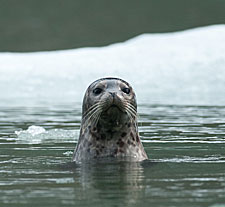Harbor Seal Research
Diet Analysis via Blubber Fatty Acids
 A decline in prey availability and quality is a common hypothesis proffered to explain declines in marine mammal populations. We used
analysis of similarity (ANOSIM) to compare blubber fatty acid (FA) signatures from 350 harbor seals in five regions of Alaska with
differing population trends: Glacier Bay, which is decreasing rapidly (-14.7%/yr 1992–2005); Prince William Sound (PWS), which is
stabilizing with an increasing short-term trend (-2.4%/yr 1990–2005; +9.0%/yr 2000–2005); Southeast Alaska, which is stable
(Sitka, +0.6%/yr 1984–2005 ) or increasing (Ketchikan, +5.0%/yr 1983–2003); Bristol Bay, which is increasing (+7.0%/yr 1995–2005);
and Tugidak Island, which is increasing (+7.5%/yr 1993–2004).
A decline in prey availability and quality is a common hypothesis proffered to explain declines in marine mammal populations. We used
analysis of similarity (ANOSIM) to compare blubber fatty acid (FA) signatures from 350 harbor seals in five regions of Alaska with
differing population trends: Glacier Bay, which is decreasing rapidly (-14.7%/yr 1992–2005); Prince William Sound (PWS), which is
stabilizing with an increasing short-term trend (-2.4%/yr 1990–2005; +9.0%/yr 2000–2005); Southeast Alaska, which is stable
(Sitka, +0.6%/yr 1984–2005 ) or increasing (Ketchikan, +5.0%/yr 1983–2003); Bristol Bay, which is increasing (+7.0%/yr 1995–2005);
and Tugidak Island, which is increasing (+7.5%/yr 1993–2004).
Dietary fatty acid composition influences the composition of blubber, thus the FA composition, or signatures from blubber, can be used to indicate variations in harbor seal diets. We found significant differences in FA signatures between all five regions. PWS and Glacier Bay were most similar (ANOSIM R = 0.355, p<0.001) and both had decreasing population trends when blubber was collected (1997–2001). We found the greatest difference in fatty acid signatures when comparing Tugidak to Glacier Bay (ANOSIM R = 0.826, p<0.001) and Tugidak to PWS (ANOSIM R = 0.837, p<0.001); regions with opposite population trends during sampling. Our analysis indicates that harbor seals from these five sites differ in diet composition, which may support the hypothesis that prey availability or quality influences population trends. Further investigation on other factors that may differ among populations is required.
Objectives:
- Determine if blubber fatty acids indicate a difference in diet between regions.
- Identify the causes of variance in fatty acid composition and rank them in order of importance (e.g., region, year, season, cohort)
- Continue to collect blubber fatty acids to examine changes over time and between regions.
This study has been conducted under MMPA NMFS permit #s 1000, 358-1585 and 358-1787. The ANOSIM analysis was done by John Moran and Jacek Maselko from AFSC/Auke Bay Laboratories, NOAA Fisheries, Juneau, AK. The harbor seal population trend data was presented courtesy of Grey Pendleton, Alaska Department of Fish and Game, Juneau, AK. For additional information concerning this project, contact Shawna Karpovich at (907) 459-7239 or email her at shawna.karpovich@alaska.gov.
